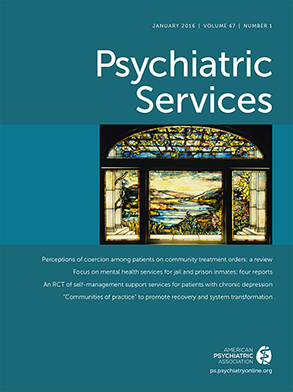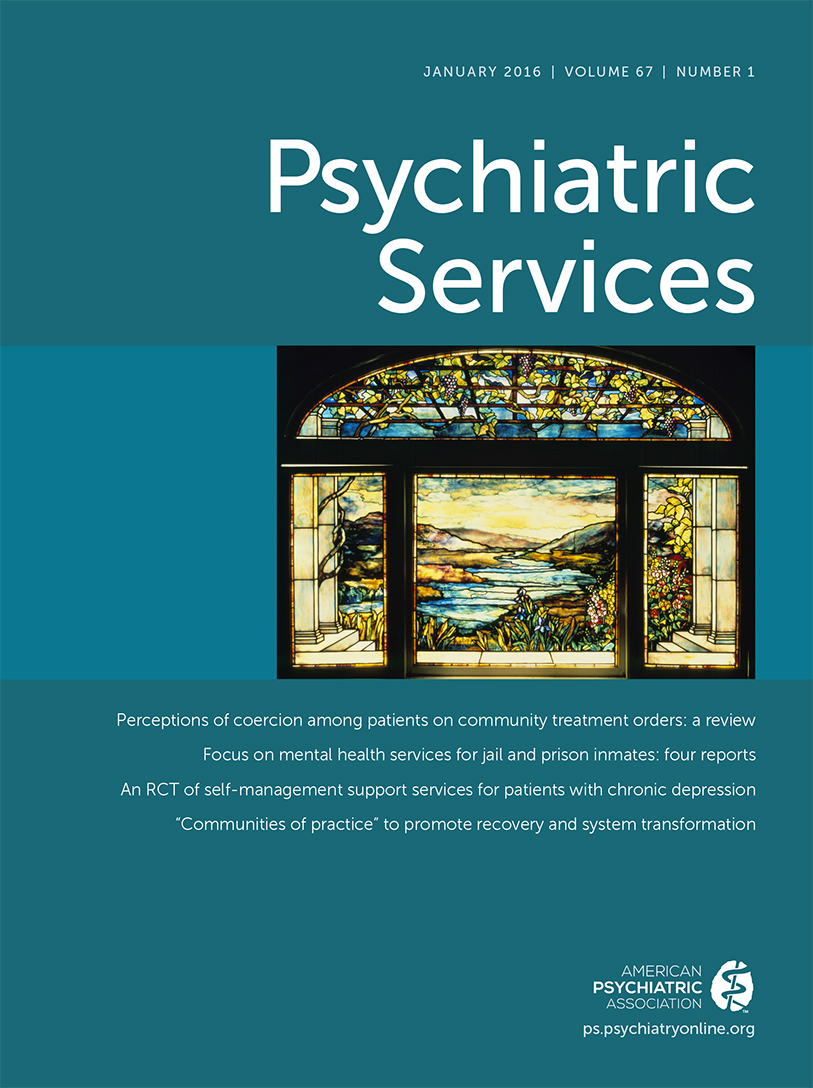In 2012, the Office of the Surgeon General and the National Action Alliance for Suicide Prevention (Action Alliance) released the National Strategy for Suicide Prevention to address the critical public health challenge of suicide in the United States (
1). Goal 8 of the National Strategy is to “Promote suicide prevention as a core component of health care services.” In addition, the Action Alliance endorsed “zero suicide in health and behavioral health care” as one of its national priorities (zerosuicide.sprc.org/about). Health care systems can be important settings for suicide prevention. A review suggested that approximately 77% of individuals who died from suicide contacted a primary care physician and 32% contacted a mental health service provider a year prior to their death (
2).
In addition, provision of follow-up care after discharge from a health care facility is an essential component of suicide prevention. Research has consistently found that the period after discharge from a hospital is one of the highest risk periods for suicide (
3). Care factors, such as lack of continuity of care and noncompliance, in addition to factors such as past suicide attempts and low social support have been shown to be associated with suicide after discharge (
4). Such evidence led to inclusion of and emphasis on improving follow-up care after discharge in the National Strategy (
1).
A systems-of-care approach for suicide prevention has been emphasized (
5). However, there is little understanding of the extent to which behavioral health facilities provide suicide prevention services. A targeted system improvement, such as that undertaken by the Henry Ford Healthcare system’s Zero Suicide Initiative, has been suggested to lower suicide rates (
6). Nonetheless, the extent to which suicide prevention services or outcome follow-up after discharge are offered as a standard of care in U.S. mental health facilities is not fully understood. To inform our efforts to improve suicide prevention within health care settings, it is first necessary to understand the characteristics of mental health facilities that offer suicide prevention services and that have standard procedures in place to follow-up with patients after discharge. Using recently available data on U.S. mental health facilities, we examined facility-level characteristics associated with the availability of suicide prevention services and outcome follow-up after discharge.
Methods
All known public and private facilities that provide mental health treatment services in the United States (hereinafter called facilities) were eligible to participate in the National Mental Health Services Survey (N-MHSS), sponsored by the Substance Abuse and Mental Health Services Administration (SAMHSA). Mental health treatment services were defined as “services focused on improving the mental well-being of individuals or promoting their recovery.” The survey was completed between June 2010 and January 2011 by a director of the facility or an administrator familiar with the operating procedures of the facility. This study reports on 8,459 of the 12,186 mental health facilities eligible for the survey. [A CONSORT diagram is available as an
online supplement to this report.] More details on N-MHSS (
7) are available on the SAMHSA Web site (
www.samhsa.gov/data/DASIS/NMHSS2010_Web.pdf). Because the data collection for this study did not involve human subjects, institutional review board approval was not required.
The following two items were used to assess whether the facilities offered some form of suicide prevention services: suicide prevention services as part of the supportive services and practices offered at the facility, and client or patient outcome follow-up after discharge as a standard operating procedure (SOP). The facilities were then divided into four categories: offered neither, offered suicide prevention services only, offered outcome follow-up after discharge only, or offered both. [Details about these measures are included in the online supplement.]
The following characteristics were included in the analysis: facility type, mental health treatment in multiple settings, primary treatment focus, supportive services, facility sponsor or operator, age group accepted, licensing, certifications, accreditations, special programs for veterans, total single-day client count, urbanicity, and region. The survey also included questions about whether facilities operated a crisis intervention team within the facility or off site to handle acute mental health issues. [A figure in the
online supplement illustrates the operation of a crisis intervention team either off site or within the facility across the four categories described above.] We further calculated the number and percentage of facilities across the categories for each facility-level characteristic examined. Because of our interest in distinguishing facilities that offered neither suicide prevention services nor outcome follow-up from facilities in the remaining three categories, we compared facilities that offered neither to facilities that offered both or either by using three logistic regression models. All analyses were performed with Stata, version 13.0 (
8).
Results
Of the 8,459 mental health facilities included in this study, approximately one-fifth (21.2%) indicated that they did not offer either suicide prevention services or outcome follow-up after discharge; about one-fifth (21.2%) offered follow-up after discharge but not suicide prevention services; one-fourth (25.0%) offered suicide prevention services but not follow-up; and close to one-third (32.6%) offered both (
Table 1).
The proportion of facilities operating crisis intervention teams was greater among those that offered both suicide prevention services and follow-up after discharge (close to 75% within or off site). Over one-third of facilities that offered neither service operated a crisis intervention team within their facility or off site [see figure in online supplement].
The examined characteristics differed across facilities offering suicide prevention services or follow-up after discharge (
Table 1). In the adjusted model, several characteristics distinguished facilities that offered neither service from those that offered suicide prevention services or follow-up after discharge [see table in
online supplement]. For example, facilities that offered a mix of mental health and substance abuse treatment, more comprehensive support services (such as disease management and coordination-related support services), and special programs for veterans were more likely to offer either suicide prevention services or follow-up after discharge or both than to offer neither service. Facilities that accepted adults only were more likely than those that accepted both youths and adults to offer neither service than to offer both or either service. Facilities certified or accredited by the Joint Commission, Commission on Accreditation of Rehabilitation Facilities, and Medicaid were more likely to offer both types of service than to offer neither service. Facilities with a larger single-day client count were more likely to offer both types of service than to offer neither service.
Discussion
This study of 8,459 U.S. mental health facilities in 2010 suggests that most offered suicide prevention services or had an SOP for outcome follow-up after discharge. However, approximately one-fifth had neither service in place, which points to a lack of suicide risk assessment, management, and prevention in these facilities. The facilities differed in characteristics such as treatment focus; age group accepted; additional supportive services offered; and licensing, certification, and accreditation.
Facilities with suicide prevention services and procedures for follow-up after discharge were more likely to provide an array of support services, treat both substance use and mental health services, and offer special programs for veterans. These results suggest an opportunity to incorporate suicide prevention services as part of the comprehensive package of support services in mental health facilities and are also consistent with increased attention to suicide prevention among substance users (
9) and veterans (
10). However, facilities without suicide prevention services were more likely to accept adults only than to accept both adults and youths. The lack of suicide prevention services in facilities that accept adults is a serious concern because a great number of suicides occur among adults (
11).
Findings highlight the gap in meeting the needs of individuals with mental disorders. Such efforts may require system-level changes, such as adopting policies and procedures related to suicide prevention, improving collaboration and communication, and improving the suicide prevention skills of the workforce (
5). In our study, over 46% of facilities had no SOP for follow-up care after discharge, which indicates a need to incorporate quality assurance procedures related to suicide prevention. Furthermore, the significant association between accreditation and offering suicide prevention services reinforces the importance of accreditation in advancing suicide prevention efforts in the mental health care delivery system. For example, in 2007, the Joint Commission included national patient safety goal 15.01.01 in the behavioral health care standards, which encourages organizations to identify individuals at risk of suicide (
12). Further, a collaborative care approach may enhance system-level change to better respond to individuals at risk of suicide. In our study, over one-third of facilities without suicide prevention services operated a crisis intervention team for individuals with acute mental health problems. Crisis intervention services can play a vital role in intervening in suicidal crises and in providing postdischarge follow-up and care transitions. Finally, system-level change requires ensuring that professionals have adequate skills and training to respond appropriately to individuals at risk of suicide. Although suicide prevention is considered part of graduate training for mental health professionals, concerns have been raised about the lack of adequate training in suicide risk assessment required among mental health professionals (
13). To address this concern, the Action Alliance recently published a core set of training guidelines for the clinical workforce on suicide assessment and intervention (
14).
The study excluded certain facilities, such as military facilities operated by the Department of Defense. The items were reported by a single designated person at each facility, and results may have been subject to reporting bias. The available data did not allow us to examine state regulatory expectations, to identify specific types of suicide prevention services that were offered in these facilities, or to determine whether affiliated facilities—for example an outpatient counterpart of an inpatient facility—offered suicide prevention services instead. Outcome follow-up was not specific to suicide, although the survey specified “after discharge,” which is an important time point for suicide prevention. The strengths of the study include use of comprehensive data on the civilian mental health care system from more than 8,000 facilities nationwide and a unique focus on facility-level characteristics associated with suicide prevention.
Conclusions
In a large survey of U.S. mental health facilities, approximately one of five did not report offering either suicide prevention services or outcome follow-up after discharge as standards of care. These facilities were less likely to offer comprehensive support services or special programs for veterans; less likely to offer substance abuse services; and less likely to be accredited, licensed, or certified. The findings highlight the continued need to improve suicide prevention services in the mental health care system.

